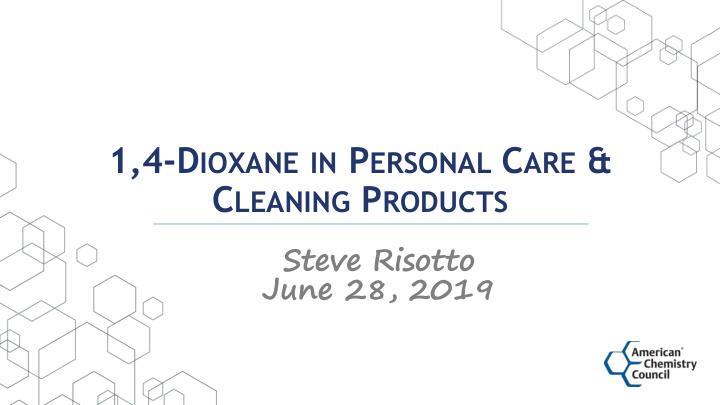



1,4-D IOXANE IN P ERSONAL C ARE & C LEANING P RODUCTS Steve Risotto June 28, 2019
Previous Conclusions Regarding 1,4-Dioxane Carcinogenicity (~2010-2013) 1,4-DX is readily metabolized at lower doses; • metabolic saturation occurs at higher doses Clear evidence that 1,4-DX and metabolites are not • genotoxic ➢ Heath Canada, WHO, and EU: tumors form only after metabolic saturation → non-linear (threshold) mode of action (MOA) USEPA 2013: there are data supporting a threshold • MOA, but -- Incomplete evidence that cytotoxicity/proliferation • precede tumors Metabolism not completely characterized • • Lack of evidence of a proliferative response
Low-Dose Extrapolation (Linear vs Threshold)
Key Events in the Regenerative MOA for Carcinogenicity Source: EPA 2013
Progression to Tumors Reg Tox Pharma 68:387-401 (2014) Liver cell toxicity & proliferation observed in reanalysis of National Cancer Institute (NCI) slides Content Reg Tox Pharma 88:45-55 (2017) Toxicokinetics characterized Threshold for metabolism identified
Characterization of Metabolism – Content fate of 1,4-DX in rodents Source: Sweeney et al. 2007
Characterization of Metabolism – Blood Levels in Female Mice (ACC data)
Proliferative Response in Female Mice (ACC data) D a y 9 0 Gene sets related to proliferation • H e p a to c e llu la r P ro life ra tio n significantly enriched after 90 days 4 0 (% B rd U P o s itiv e C e lls ) at 6000 ppm 3 0 • Regulation of Mitotic Cell Cycle • Negative Regulation of Mitotic Cell Cycle 2 0 • Mitotic Cell Cycle Checkpoint • Positive Regulation of Mitotic Sister 1 0 Chromatid Separation • Mitotic G1-G1 S Phase • M-G1 Transition 0 • Cell Cycle Mitotic 2 0 0 0 6 0 0 0 4 0 2 0 0 6 0 0 0 1 ,4 D io x a n e (p p m ) •
Differential Gene Expression (ACC data) More typical gene expression plot Alterations at the transcriptomic level are minimal Alterations at the transcriptomic level were minimal, but with a clear threshold demonstrated • For reference: example plot from analysis pipeline manual 6000 ppm at 90 days
Key Events in the Regenerative MOA for Carcinogenicity Source: EPA 2013
Recommend
More recommend